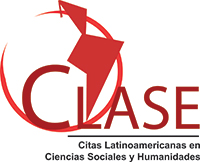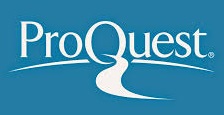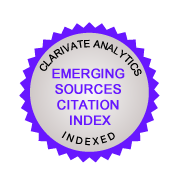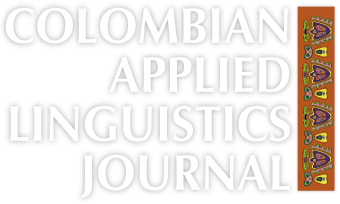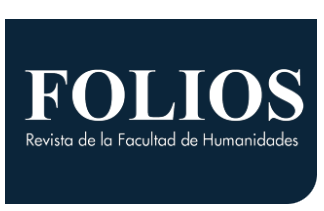Increasing EFL Learners’ Oral Production at a Public School Through Project-Based Learning
Incremento de la producción oral de aprendices de inglés como lengua extranjera en una escuela pública mediante el aprendizaje basado en proyectos
DOI:
https://doi.org/10.15446/profile.v19n2.59889Keywords:
Communicative competence, English as a foreign language learning, project-based learning, speaking skill (en)aprendizaje del inglés, aprendizaje basado en proyectos, competencia comunicativa, habilidad de habla (es)
This research study examined how a group of ninth graders enhanced the speaking skill in an English as a foreign language classroom through project-based learning. Data about the experience were collected through field notes, transcripts of learners’ oral performance, and one interview. Grounded theory was implemented for data analysis, out of which three main findings emerged: (1) project-based learning encouraged students to increase oral production through lexical competence development, (2) helped them to overcome fears of speaking in L2, and (3), increased their interest in learning about their school life and community.
https://doi.org/10.15446/profile.v19n2.59889
Increasing EFL Learners’ Oral Production at a Public School Through Project-Based Learning
Incremento de la producción oral de aprendices de inglés como lengua extranjera en una escuela pública mediante el aprendizaje basado en proyectos
Ady Marcela Vaca Torres*
Colegio Virginia Gutiérrez de Pineda, Bogotá, Colombia
Luis Fernando Gómez Rodríguez**
Universidad Pedagógica Nacional de Colombia, Bogotá, Colombia
*adymarcela@hotmail.com
**lfgomez@pedagogica.edu.co
This article was received on September 2, 2016, and accepted on January 6, 2017.
How to cite this article (APA, 6th ed.):
Vaca Torres, A. M., & Gómez Rodríguez, L. F. (2017). Increasing EFL learners’ oral production at a public school through project-based learning. PROFILE Issues in Teachers’ Professional Development, 19(2), 57-71. https://doi.org/10.15446/profile.v19n2.59889.
This is an Open Access article distributed under the terms of the Creative Commons license Attribution-NonCommercial-NoDerivatives 4.0 International License. Consultation is possible at http://creativecommons.org/licenses/by-nc-nd/4.0/.
This research study examined how a group of ninth graders enhanced the speaking skill in an English as a foreign language classroom through project-based learning. Data about the experience were collected through field notes, transcripts of learners’ oral performance, and one interview. Grounded theory was implemented for data analysis, out of which three main findings emerged: (1) project-based learning encouraged students to increase oral production through lexical competence development, (2) helped them to overcome fears of speaking in L2, and (3), increased their interest in learning about their school life and community.
Key words: Communicative competence, English as a foreign language learning, project-based learning, speaking skill.
Esta investigación analizó cómo un grupo de grado noveno afianzó su producción oral en inglés mediante el aprendizaje basado en proyectos. Se recogieron datos sobre la experiencia en notas de campo, trascripciones de las producciones orales de los estudiantes y una entrevista. El análisis de los datos generó tres hallazgos principales: el aprendizaje basado en proyectos motivó a los estudiantes a aumentar su producción oral mediante el desarrollo de la competencia léxica, les ayudó a superar el temor de hablar en la lengua extranjera e incrementó su interés por aprender sobre su vida escolar y su comunidad.
Palabras clave: aprendizaje del inglés, aprendizaje basado en proyectos, competencia comunicativa, habilidad de habla.
Introduction
One of the major limitations that English as a foreign language (EFL) learners encounter in their language learning process is that they do not have many opportunities to practice speaking other than in the classroom. As they live in countries where the first language is not English (e.g., China, Spain, and Latin American countries), opportunities to improve their oral communicative skills are reduced. EFL learners can find ways to practice reading, listening, and writing as they have easier access to aural and written materials outside the classroom with the support of textbooks, short stories, and the Internet (news, songs, movies, digital books, magazines, and online courses). However, aside from the teacher, they can hardly find conversation partners to practice speaking their L2. Moreover, in EFL classrooms, where large groups of students exceed the ideal number to practice speaking and the hours allotted per week to study English are reduced (Urrutia León & Vega Cely, 2010), learners’ speaking production is scarce and problematic. Therefore, many times learners confront negative feelings about speaking English due to the fact that they are not often stimulated to adopt active speech roles, and have few contexts in which to speak it for communicative purposes (Khan, 2010; Savaşçi, 2014).
That is why this action research study looked into how a group of Colombian EFL learners at a public school could have more opportunities to develop their speaking skills through project-based learning (PBL). The emphasis on speaking skills represented an initial attempt for the learners to improve their communicative ability, as they were encouraged to complete class projects related to real life situations in which speaking became a communicative need. It is important to clarify that the four communicative skills (reading, listening, speaking, and writing) should be equally practiced in the communicative classroom. However, because of the particular needs of the learners involved in this study, the research focus was to solve their speaking limitations.
Statement of the Problem
In a 2015 diagnostic survey, a group of thirty students from a public school in Bogotá reported that in their English courses speaking was limited to practicing pronunciation and answering the teachers’ questions to verify reading and listening comprehension. During classes, it was also observed that while students were more receptive to grammar activities, reading, listening, and writing, speaking was the least practiced language skill as learners recognized that they were shy and afraid of participating orally in class because they did not master enough structures and fluency to express basic ideas.
Another problem detected in the classroom was that learners were reluctant to speak in English and did not invest much in fostering it. Since they preferred to complete the language tasks with their closest friends, they ended up speaking in Spanish as they were used to doing it in other subjects and in their daily lives. Moreover, they often mocked each other when they made pronunciation and grammar mistakes the few times they participated in class. Therefore, learners were scared of being ridiculed by their classmates. This unpleasant environment increased students’ negative attitudes towards learning, since they neither helped each other nor liked speaking tasks.
EFL students’ sense of individuality and fears of speaking English were also increased by the language teaching methods adopted by some teachers at this school. It was found in the diagnostic survey that teaching in previous English courses was mainly based on grammar activities in which drilling and filling in blanks were the main purpose. All these trials obviously reduced learners’ interest in speaking English. Thus, there was a need to find other ways to promote more communicative activities to enhance speaking and the negotiation of meaning. Therefore, we considered that one possible way that could foster these learners’ speaking skill was PBL.
Theoretical Framework
Project-Based Learning
PBL is a constructivist instructional method that supports students’ learning process through group work and social interaction in order to solve problems. Students are not only encouraged to complete the steps of class projects related to their personal interests and needs, but also to develop the ability to think critically and use content knowledge (Kapp, 2009; Tamin & Grant, 2013). PBL also generates collaboration as students help and learn from each other and feel responsible for completing projects that involve the classroom, the school, the community in which they live, and wider real-world problems (Kolodner et al., 2003; Markham, 2011). In this sense, PBL implies learning by doing through which students act as problem solvers and have to develop collaborative skills to tackle challenges and conduct research on significant issues for them (S. Bell, 2010; Blumenfeld et al., 2011).
PBL is a broad instructional model adjustable to all areas of knowledge and different types of learners (S. Bell, 2010; Habók & Nagy, 2016). Although there is a fair amount of publication on the use of PBL in many areas of knowledge such as science, social studies, and math, published research on its implementation in EFL education is still scarce (Beckett, 2005; 2006) as is the case in Colombia. Some of the main influential Colombian researchers who have implemented PBL are Bello Vargas (2012), Pinzón Castañeda (2014), and Díaz Ramirez (2014), among others. However, more research needs to be conducted. That is why this research study argues that PBL should be considered as a possible motivating factor to help EFL learners enhance foreign language competence, including speaking skills, in particular. Pinzón Castañeda (2014) states that EFL learners do not only construct knowledge, but also use the foreign language when they engage in solving real-world problems. Similarly, Dooly (2013) and Dooly and Sadler (2016) affirm that, since PBL requires teamwork, learners inevitably have to produce oral communicative forms in the target language. Learners have to make decisions, negotiate, and arrive at a consensus as they complete the steps that projects demand. This collaborative learning process is inherent in PBL and can help language learners reach better levels of language proficiency.
According to Tamin and Grant (2013), when using PBL in any school subject, several challenges need to be overcome: First, the classroom is no longer dominated by a teacher-centered approach. Thus, in the case of the EFL classroom, the teacher cannot totally control the production of language forms/functions in a sequential and orderly fashion. Language rather stems from the communication needs and the topics addressed during the development of the projects. Learning is constructed from a student-centered pedagogy in which learners’ needs to negotiate meaning are more authentic but less predictable. Second, the teacher needs to be tolerant and flexible as to the dynamics of the classroom. Third, classes are based on content or subject matter that might not be familiar to teachers’ area of knowledge or expertise (Grant, 2011; Tamin & Grant, 2013). In this regard, this research study points out that EFL teachers need to be careful with the selection of topics so that they are neither difficult for learners nor unmanageable for teachers. Despite these challenges, PBL can lead EFL students to learn the foreign language by focusing more on content than on form, as they have a communicative purpose to construct knowledge, rather than just directing their full attention on grammar use. The teacher can introduce new topics that can “motivate, focus, and initiate student learning,” breaking traditional models of education (Duch as cited in Larsson, 2001, p. 2).
Speaking Skill Development in EFL
The vision of speaking in this study was framed within communicative language teaching (CLT), an approach that aims at helping learners develop communicative competence: the ability of “classroom language learners to participate in the negotiation of meaning” and “the need for learners to have the experience of communication . . . as distinct from their ability to recite dialogs or perform on discreet-point tests of grammatical knowledge” (Savignon, 2001, p. 16). That is to say, instead of studying grammar structures, as happens in many EFL settings, learners are encouraged to negotiate meaning orally through communicative language regardless their proficiency level. Consequently, CLT highlights language learning under certain conditions: Learners use language for authentic and meaningful communication as classroom tasks have a communicative purpose, oral and written fluency is an important aspect of communication, and learning is a process of construction involving trial and error (Littlewood, 1981; Richards & Rodgers, 2014; Savignon, 2001). In other words, learners have the right to make pronunciation and grammar mistakes during social interaction in the target language as it is a normal part of the learning process.
Speaking in EFL should aim to achieve communicative goals. It requires understanding how the language works, its components and functions; and how and when to speak adequately according to circumstances of real life. For Bygate (1987) speaking involves “making decisions rapidly, implementing them smoothly, and adjusting our conversation as unexpected problems appear in our path” during communicative experiences (p. 3). Thus, adjusting oral production implies facilitation and compensation processes. Facilitation entails features that learners use to make their oral productions clearer according to their language level, including simplification (connecting sentences with conjunctions and, but, or avoiding using complex sentences) and time creating devices (strategies that give the speaker more time in order to form sentences such as fillers, hesitation, repetitions, e.g., erm, you see, I mean, kind of, etc.) (Bygate, 1987; Díaz Larenas, 2011). By contrast, compensation is related to the ability of repairing failures in oral communication by modifying what the speaker has already said in order to clarify misunderstanding or restate an idea that has been difficult to express. Compensation devices include “conversational adjustments” such as self-correction, substitution, rephrasing, and repetition, making sure that the other has understood (Bygate, 1987; Díaz-Larenas, 2001; Lázaro-Ibarrola & Azpilicueta-Martínez, 2014). These two features were important for the researchers who knew that the student participants of this study were going to struggle to communicate and construct meaning, since this was the first time that they were going to be involved in oral communicative activities through solving projects.
Additionally, Bygate (1987) explains that learners need to develop skills of interaction and skills of negotiation. Interaction skills involve the social norms of when and how to speak with appropriate words, correct grammar, and organized discourse during a conversation, while negotiation of meaning refers to the skills of reaching a full level of clear understanding. It involves repeating, rephrasing, and restructuring phrases between two or more learners to understand the meaning of the messages they are communicating (Rees, 1998). These insights about speaking development in EFL constituted the key elements to help learners improve oral production and communicative competence through PBL.
Research Design
Research Question
The research question leading this study was: How could project-based learning influence a group of ninth EFL graders’ speaking skill development?
Research Type
This was an action research study. Action research embraces the actions needed to solve a given problem in the classroom (J. Bell, 2005). It consists of several self-reflective cycles in which teacher-researchers complete four steps: plan to initiate a change, act and observe the process of implementation, and reflect on possible results (Kemmis, McTaggart, & Nixon, 2014). In particular, the researchers of this study (1) planned three cycles to solve the problem by encouraging EFL learners to develop speaking skills, (2) acted by designing and implementing a pedagogical intervention supported by one project for each cycle (see Table 1), (3) observed through data collection instruments how learners responded to the projects’ development and completion, and (4) reflected on the experience by analyzing the data collected in order to make decisions and generate more effective classroom strategies (Parsons & Brown, 2002).
Setting and Participants
This research study was conducted at a public school in a Northwest neighborhood of Bogotá, Colombia. Students came from families whose parents made a great effort to raise them properly. In this context, where Spanish is the official language, learners did not have any contact with the English language and much less any practice speaking other than in the English class which was scheduled three hours a week only. Thirty EFL ninth graders were involved in the study, 19 girls and 11 boys, whose ages ranged from 13 to 15 years old. They had a basic English language level and, as explained in the statement of the problem, they were shy and did not feel confident when they had to do speaking activities. Most of them were afraid of oral production in English.
Pedagogical Intervention
Table 1 shows that students developed three projects through which they were encouraged to speak English to achieve communicative needs. The projects were related to their personal lives and environment in such a way that they had the opportunity to speak about meaningful information from their own reality. From a constructivist perspective, the projects aimed at generating collaboration as students were expected (1) to help and learn from each other, (2) work at their own pace, and (3) feel responsible for completing projects that involved the classroom, the school, the community in which they lived, and wider real-world problems. In the first project, “Discovering who my classmates are: Sharing common ideals and respecting differences,” students had the opportunity to interview a classmate they did not hang around with that much, or never spoke to. The purpose was to help learners create friendly bonds since, as explained in the statement of the problem, there were attitudes of selfishness and learners ridiculed each other’s pronunciation. Also, the purpose of this project was to recognize the human side of their partners, despite the possible differences that could exist among them. The second project, “Is everything fine at school? Making proposals to improve our school problems,” encouraged learners to investigate through a survey the perceptions of the school community in regard to serious problems at this institution. So, they conducted a survey involving students from other courses, teachers, and school administrators. The third project, “Getting involved in my neighborhood,” attempted to make students become aware of their neighborhood’s needs and problems and to become friendlier with the community, since part of the community sometimes complained about the impolite behavior of several students that bothered some neighbors after the school day.
So, authorization from the school board of directors was needed to take the children out of the school and visit their neighborhood to complete the project. It is important to clarify that the people in their community did not speak English at all. One interesting strategy that students proposed to overcome this difficulty was that they shared responsibilities. So, it was observed that in each group one student interviewed the neighbors in English, another student translated the questions into Spanish, the neighbors answered the questions in Spanish, and all the students in the group took notes by translating into English the neighbors’ answers. Translation was only accepted on this rare occasion because learners were encouraged to use the foreign language all the time during the completion of the projects. So, this communicative interaction resulted in a fun, interesting, and safe activity as students were trying to overcome barriers in communication when actually doing the field work.
The completion of the projects was difficult and time-consuming because it was not easy for learners to use the English language right away. It was a slow process, especially because these learners had never practiced speaking that often and because they had never done projects in the target language before. Speaking production was emphasized in all the projects since oral communication was needed when the groups had to work together to prepare the questions for the interviews and surveys, to conduct the actual interviews or do field work, and when they planned and organized the ideas and findings for the oral presentations and oral reports (see Table 1). Thus, speaking became the central means to communicate most of the time, and it was supported by writing when students took notes related to the information collected during the interviews and surveys.
Data Collection Instruments
Three instruments were implemented to collect data about the conditions, the language level, and the way class projects influenced students’ oral production. Following Johnson and Christensen’s (2012) advice, field notes were taken in every single session and right after class with the support of video recordings while participants interacted during each project completion. Extended notes were also written right after each class session by paraphrasing or entering verbatim transcripts of students’ conversations. These field notes were accompanied by the teacher-researchers’ analytical comments about the experience.
The second instrument was the transcription of students’ oral productions during the development of the projects which represented verbatim oral language in written form (Bailey, 2008). Transcripts allowed the researchers to analyze learners’ oral production during the communicative situations. They showed the speaking act in a real time (Yin, 2011). Although transcribing oral language was a time-consuming technique, specific aspects of students’ oral production to complete the tasks were more effectively detected such as the vocabulary and language level they had, the difficulties with language production, and the interactions and roles established during the projects development.
Interviews constituted the third instrument that helped the researchers obtain relevant information from participants’ personal opinions about the experience. They were useful to collect further data that were not palpable or visible (Patton, 2002; Seidman, 2006) such as participants’ thoughts, feelings, and perceptions of the topic under investigation. The interviews were held in Spanish and conducted in small groups at the end of the experience. The information gathered through transcripts of students’ oral productions, field notes, and interviews were saved in folders, and systematized by using AtlasTi 6.2 software.
Data Analysis
Field notes were analyzed by following the grounded approach method which embraces an in-depth inductive discovery of patterns in the collected data, aiming at answering the research question (Charmaz, 2012). Patterns lead to establishing logical relationships in the data that, once being grouped, are given a name (initial categories or themes) representing all the patterns. In this experience, data analysis involved the identification of initial patterns related to how learners produced oral language through project development. Then, through a process of triangulation (Freeman, 1998), patterns identified in the field notes were compared to the transcripts of students’ oral performance and their comments in the interviews to set initial pre-categories that represented all the data collected in the instruments. Finally, definitive categories were stated as a result of the whole triangulation analysis and these are presented as findings later on. For example, field notes showed that students always needed to learn vocabulary in order to form sentences orally. This pattern was also found in the transcripts and in the interviews because learners said that they needed to learn vocabulary all the time to complete the steps of the projects. Therefore, this pattern was classified under the initial category: “vocabulary learning.” At the end, this category became a formal statement/finding called: “PBL Incited Learners to Increase Oral Production through Vocabulary Learning”, representing the importance of vocabulary learning to construct meaning when completing the projects. These findings in the form of statements will be analyzed later in detail.
Findings
PBL Incited Learners to Increase Oral Production Through Vocabulary Learning
Data revealed that PBL played an important role in inciting learners to increase their language competence as they had a strong need to learn and use vocabulary in order to express ideas and to complete the tasks required in the projects (see Table 1). From the beginning of the experience, students started to change their negative perceptions on speaking English despite their basic English language level. Learners’ oral language competence was determined by their urgent need to improve their vocabulary through two social strategies:
The first strategy was peer support by asking for and providing vocabulary and expressions, which was used during the development of the three projects, including, for instance, (1) the preparations of the questions to interview other people, (2) the rehearsal to practice the questions appropriately during the different projects, (3) the actual interviews and field work, and (4) the oral reports in front of the class once students had completed the field work. Peer support by asking for and providing vocabulary during the communication process can be recognized as a constructivist feature, since PBL allowed students to share their knowledge about the foreign language and about the discussion topics when more advanced language learners offered support to those learners having difficulty with communication and with the tasks. Peer support was observed, for instance, when learners worked on Project 1 and needed to prepare the questions to interview one of their classmates:
Karen: How do you ask si tiene mascotas? (if you have any pets?)
Tatiana: No sé, sólo sé que mascotas es pet. (I don’t know; I only know that mascotas are pets)
Karen: Entonces debe ser como “you have pet?” (Then, you might ask something like “you have pet?)
Tatiana: Pues sí. (I think so)
Karen: La última pregunta podría ser sobre el tiempo libre. (We could ask a last question about free time activities). “What you...” How do you say hacer?
Tatiana: (The student looked up the word in the dictionary) Mire la palabra “hacer” es make. (Look, the meaning of “hacer” is “make.”)
Karen: Sería “What you make...” ¿Qué seguiría? (Then it would be “What you make...What is the next word?)
Tatiana: Tiempo libre es free time.
Karen: Ah ya sé, (Wait, I know) “What you make free time?” (Transcript, 11-05-2015)
This example indicates that students had serious limitations with vocabulary and grammar to ask orally basic personal information questions. For instance, Tatiana helped her classmate with a word she knew, “pet.” Then, she looked up the word “hacer” in her bilingual dictionary to complete the question “What do you do in your free time?” Although she picked up the wrong verb, make instead of do, and although both learners mostly used L1 to communicate in the first project, it was observed that they not only made a great effort to produce English language to the best of their abilities, but were mutually supportive through scaffolding. They progressively learned the foreign language in their urgent need for vocabulary and sentence formation due to the fact that there was a communicative purpose to be accomplished, an important aspect for building communicative competence. Peer support for vocabulary building was a constant factor among all participants during the development of the three projects despite the many grammar mistakes they made and the use of L1. That is to say, learners struggled to negotiate meaning orally through communicative language regardless of their limited language level, a fact that resonates with Savignon’s (2001) view of communicative language learning in that learners are challenged to use the foreign language through a process of trial and error, a strategic investment for their language progress. Thus, since the projects requested learners to conduct interviews of different people, they slowly enhanced their lexical competence and language oral skill, an aspect found in all the field notes because speaking was practiced to achieve communicative goals as suggested by Bygate (1987).
The second social strategy that students implemented to satisfy their urgent need to communicate orally was asking the teacher for unknown vocabulary and expressions. In many traditional English classrooms, the teacher is the one that mostly asks questions to verify students’ language knowledge or comprehension. By contrast, through PBL it was observed that learners continuously took the initiative to ask the teachers questions as they were conscious of their lack of vocabulary, a limitation that restrained them from building complete questions and sentences orally. In fact, at the beginning of the experience they ended up using L1 most of the time because their competence was limited. Therefore, they started to get direct support from the teachers to enhance their oral production. In this example, a group of students prepared the questions for an opinion survey on bullying, one topic of the second project about school problems.
Sara: Teacher, how do you ask, “You know any student bullying other?”
Teacher: You should say “Do you know any student bullying another.” It is “another.”
Miguel: OK. Vamos con la question number five. How do you say “si busca ayuda?”
Teacher: “Seek any help” (Miguel was trying to ask the question: “Do you seek any help from teachers to report bullying?). (Transcript, 25-05-2015)
This piece of data reveals that even though students were motivated to work together to provide each other with vocabulary, they also confirmed with the teacher if the words where actually correct, as happened with one of the teacher’s explanations about the correct use of “another” and “other” and “seek for help.” As students had limitations making complete sentences and they knew isolated words, they expected the teachers’ approval and support because they were worried about asking the questions in correct English when conducting the survey of the school community.
Data analysis also indicated that speaking productions, inherited within PBL, led learners to assume the role of problem solvers as they participated actively to complete the steps of each project rather than waiting for the teacher to tell them exactly what to do. In fact, it was confirmed by Grant’s (2011) statement that project-based learning is an ideal teaching approach through which learners collaborate with others and with the teacher through scaffolding, problem resolutions, and opportunities for reflection on the topic worked and on the language needed to communicate. Also, PBL involved these students in real life situations (getting ready with questions to interview other people), as they started to develop the need for meaning construction through social support and interactional functions of oral discourse.
PBL Helped Learners to Overcome Fears of Speaking in L2
Throughout the whole experience learners were afraid of speaking in L2, and they were never able to leave their fears behind. For instance, when working on the first project (see Table 1), it was observed that learners did not produce complete sentences in English, did not pronounce correctly, and mostly spoke in Spanish. They were not only embarrassed and hesitant to use L2, but were afraid of being mocked by classmates and concerned about what the teacher could think of their oral production. Learners said that they were nervous every class, a situation detected in all the field notes, and later corroborated in the interview at the end of the pedagogical experience, as evidenced in this example:
Teacher: Darcy, ¿Cómo te sentiste durante el primer proyecto? (How did you feel doing the first project?).
Darcy: En mi cabeza pasó que iba a hacer “el oso” (I thought I was going to look ridiculous).
Teacher: ¿Por qué? (Why?)
Darcy: Porque es que la pronunciación es muy fea, es muy rara, es difícil (because pronunciation is ugly, odd, and difficult).
Teacher: ¿Lograbas entender las preguntas que se te hacían? (Did you understand your classmates’ questions?).
Darcy: Sí, más o menos (Yes, more or less). (Interview, 13-08-2015)
When Darcy said: “hacer el oso,” which is a colloquial Spanish expression in Colombia that stands for “to look ridiculous,” she was nervous about speaking English because she thought she did not have good English pronunciation. Thus, she self-criticized severely because she thought that her classmates would make fun of the way she spoke English. In fact, feelings of fear and anxiety were detected when students smiled nervously, covered their mouths with their hands, and spoke in whispers because they did not want to be heard and felt embarrassed in front of their classmates. However, through PBL students found peer support strategies to help each other with the construction of meaning in the target language, and this support stimulated them to overcome fears of speaking by adopting two strategies.
The first strategy was preparing/rehearsing their oral productions. Although learners showed that they were nervous and insecure, they found it useful to prepare/rehearse their oral productions with the possible language they expected to use during the interviews and surveys that the three class projects demanded. Sometimes they practiced the questions that they had prepared for the surveys/interviews before actually doing field work. Other times, they rehearsed the interviews with their closest friend before actually interviewing the school community or the people in the neighborhood. Moreover, writing was used as part of the rehearsals of the oral productions because students wrote and reviewed the questions they were planning to ask in the interviews and rehearsed target answers that they predicted interviewed people would answer. This practice gave them more security to practice speaking and reduce negative feelings. The teacher-researchers were always there helping them with the language being rehearsed. One interesting example to point out as regards how learners overcame their fear of speaking was that they not only wrote the questions to do the field work, but also had the initiative to design PowerPoint presentations for the oral reports, containing the information they had collected during the survey. Such was the case of the learners who reported on students’ perceptions of fights at school, a problem they researched to complete Project 2. For example, one student started the presentation by saying, “Our survey was about school fights.” Then he said, “It seemed to us an important issue.” One of his co-workers added “all persons see one.1” Then, they reported that many students had seen or participated in a fight at school, implying that violence and intolerance among learners were “a big problem in general” (Field notes, 19-06-2015). When giving this report, learners supported their speaking production with the use of PowerPoint presentations to remember and produce orally key ideas related to that topic. Prior to this formal report, they rehearsed their oral production, and this preliminary preparation reduced significantly their fears and negative attitudes towards speaking in English in front of the classroom. The important achievement with this preparation/rehearsal and these oral presentations is that learners were actually producing oral language in the foreign language despite their language limitations and fears. These communicative constructions involved trial and error as explained by Littlewood (1981) and Savignon (2001), since learners made pronunciation and grammar mistakes during social interaction, but struggled to negotiate meaning orally in order to meet communicative purposes thanks to the demands of PBL.
The second strategy that diminished fears of speaking in L2 was code-switching and translation. It was observed that due to their low English level, students constantly moved back and forth between English and Spanish when doing the steps of the projects because it not only helped them control their feelings of anxiety, but provided them with security to put up with the speaking projects as can be seen in this example when one learner was conducting the actual interview of a classmate to complete Project 1:
Nazly: What’s your personality?
Ana: Shy and...friend...friendly.
Nazly: What are your goals in life?
Ana: Study in the university, (laughing) ¿Así?, ¿Esa es la respuesta?
Nazly: Sí. Vamos bien . . . What are your plans para el futuro?
Ana: To travel, viajar, ¿cierto?
Nazly: Pero diga dónde ¿Cuál país?
Ana: Paris.
Nazly: (laughing) Paris no es un país.
Ana: ¡ahhh!! (Transcript, 20-05-2015)
This sample shows that students moved back and forth between English and Spanish because they tried to compensate for failures in communication and deal with fluency problems. Nazly’s sentences in Spanish such as “Vamos bien” and “pero diga dónde ¿Cuál país?” indicate that she, as has happened to other learners, felt the necessity to use their native language in order to verify if they were doing the activity correctly and were being understood in the foreign language. This verification diminished their fears of communication failure in oral production. Indeed, code-switching seemed to occur due to the fact that these learners were using simultaneously the native and the foreign language grammars, trying to figure out how to speak appropriately in the communicative process. One reason why these participants had the tendency to code-switch was to reduce their feelings of frustration in regard to issues of facilitation and compensation in oral production, a phenomenon that took place during the whole pedagogical intervention.
In the previous example, we can observe that while Nazly was more fluent and more confident to speak L2; Ana’s answers were simple, brief, and almost monosyllabic as she did not want to put herself at risk. “Shy and friendly,” “To travel,” and “Paris” indicate that Ana used facilitation strategies to make her oral performance easier, avoiding the use of complex sentences according to her language level. Similarly, Ana used translation as a compensation strategy for making sure she did not fail in oral communication such as when she translated all her answers into Spanish to be ready for possible corrections and make sure that her partner understood, these being key strategies discussed by Bygate (1987) and Lázaro-Ibarrola and Azpilicueta-Martínez (2014). Therefore, code-switching and translation, accompanied by compensation and facilitation strategies were implemented by all the participants in this experience in order to achieve the communicative purposes in L2 that the projects requested. The important contribution of PBL in this EFL setting was that learners were exposed to speaking English regardless of their accuracy and fluency levels. Hence, more authentic communication took place through the development of the three projects.
PBL Raised Students’ Interest in Talking About Their Own Experiences and the Community
With PBL, learners necessarily did investigative work in their real-world context. In doing so, they not only used the foreign language more often and with a communicative purpose, but raised interest in talking about their classmates’ personal lives, their school problems, and their community. Therefore, their inquiry contained a social and humanitarian emphasis, since the goal of the projects was to help students show concern for their own individuality and human qualities as well as to value and respect other human beings around them such as other students, teachers, and neighbors.
During the first project students learned to see their classmates with different eyes because through their investigations, they discovered a different side of their classmates’ personal and family levels, and had the opportunity to interact with a classmate they did not speak much to. This close interaction created feelings of empathy and respect for their partners. The following is a sample of the oral reports students gave in front of the class once they had finished the investigative work on one of their classmate’s life.
Laura: Santiago has 15 years old. He is a student in vgp school. He likes hamburger and pasta. He has a sister and another sister, she is in seventh grade. He live with mother, his father is in Cali. He [Santiago’s father] not lives with the family. He [Santiago] loves the mother and . . . he like to cuidar his sisters [sic]. (Field notes, 25-05-2015)
Although the oral production in this sample may seem basic, it actually represented a great speaking achievement for the learners during the experience, taking into account that they were totally reluctant to speak in L2 before. The projects motivated students to actually use L2 orally despite grammar mistakes and limitations because they were interested in their partners’ life experiences. Moreover, this sample evidenced how learners were able to report new knowledge about one person they rarely talked to in class, and learned to see their classmates as human beings similar to them, having other roles and life stories apart from their academic life. In this case, for example, Laura discovered that Santiago’s parents were divorced and lived in different cities, and that he was very caring with his sisters and mother, providing emotional support for his family as he had become the man of the house. Thus, learners developed sympathy, respect, and admiration for their classmates’ life stories and sometimes difficult experiences as noticed through the tone of voice in their oral reports. This can be corroborated with students’ opinions in the interview:
Teacher: I’d like to know how you felt doing the third project.
Salcedo: Es bueno porque uno conoce más a los compañeros, sobre su familia, sus gustos, lo que quiere hacer en la vida. Tambien se aprende de nuestro propio colegio (It’s good because one can learn about our partners, about their families, likes, and plans for the future lives. We can also learn about our own school.) (Interview, 13-08-2015)
A similar case happened when learners did the third project and discovered that the people living in their neighborhood suffered from delinquency and injustice as there were many thieves that threatened and robbed people walking in the street or vendors in their own shops. In this sense, learners recognized how the projects not only facilitated language knowledge, but content knowledge as they became aware of personal and collective issues in their own context, empowering themselves with a more humanistic, tolerant, and friendly attitude towards valuing others’ individuality, personal life, and social conflicts at school and in the community.
Conclusions
Based on this research experience, it can be concluded that the incorporation of PBL in EFL learning incited learners to enhance their communicative competence with a major emphasis on the speaking skill. Learners needed to negotiate meaning orally in order to meet communicative purposes, a learning process which was mainly determined by their need to build up their lexical and grammar competences. Data showed that they were concerned about learning language to communicate messages related to their personal interests and academic needs, rather than just learning words in isolation as traditionally done in many EFL classes. Moreover, despite their language limitations, such as grammar mistakes, incorrect pronunciation, and poor fluency and accuracy, learners made a great effort to speak English and get involved in conversations in order to communicate and negotiate meaning.
One of the salient conclusions of this research project was that through PBL students gradually, although not that easily and totally, left their fears of speaking aside. They reduced significantly high levels of insecurity, anxiety, and tension through peer support as they asked for and provided each other with vocabulary and expressions, and asked the teacher to help them construct sentences in oral form. Other strategies that diminished their fears of speaking were code-switching and translating, as they felt better when they confirmed in the native language that their oral productions were right and understood. It is important to emphasize that these participants never stopped speaking Spanish, their native language, during the completion of the projects, precisely because this was the first time they were working with projects, and sometimes they found it difficult to express orally their thoughts and ideas. However, they started to use the target language more often and freely in comparison to their unwillingness and inhibition to speak it in previous English courses.
When working with projects, learners became more responsible and autonomous, and assumed the roles of investigators and problem solvers because they had to make decisions, negotiate meaning, and reach agreements related to the steps that projects requested. Although it was time-consuming and demanded meticulous preparation on the part of the students and the teachers, students were more motivated to learn because they were both busy and learning by doing.
This study also concludes that PBL should be implemented in different EFL settings, more specifically, in public schools in Colombia where students have limited hours to practice English and where speaking is the least practiced skill. With PBL, learners can be involved in speaking activities through which they use the language as a communication means and for acquiring information and knowledge, rather than just focusing on grammar practice.
1The student meant "all people at school have seen one (one fight)."
References
Bailey, J. (2008). First steps in qualitative data analysis: Transcribing. Family Practice, 25(2), 127-131. http://doi.org/10.1093/fampra/cmn003.
Beckett, G. H. (2005). Academic language and literacy socialization through project-based instruction: ESL student perspectives and issues. Journal of Asian Pacific Communication, 15(1), 191-206. http://doi.org/10.1075/japc.15.1.12bec.
Beckett, G. H. (2006). Project-based second and foreign language education: Theory, research, and practice. In G. H. Beckett & P. C. Miller (Eds.), Project-based second and foreign language education: Past, present and future. (pp. 3-18). Charlotte, US: Information Age Publishing.
Bell, J. (2005). Doing your research project (4th ed.). New York, US: Open University Press.
Bell, S. (2010). Project-based learning for the 21st century: Skills for the future. The Clearing House, 83(2), 39-43. http://doi.org/10.1080/00098650903505415.
Bello Vargas, I. (2012). A language-in-use study of EFL students’ social discourses in project-based learning. Colombian Applied Linguistics Journal, 14(1), 108-126.
Blumenfeld, P. C., Soloway, E., Marx, R. W., Krajcik, J. S., Guzdial, M., & Palincsar, A. (2011). Motivating project-based learning: Sustaining the doing, supporting the learning. Educational Psychologist, 26(4), 369-398.
Bygate, M. (1987). Speaking: A scheme for teacher education. Oxford, UK: Oxford University Press.
Charmaz, K. (2012). The power and potential of grounded theory. Medical Sociology Online, 6(3), 1-15. Retrieved from http://www.medicalsociologyonline.org/resources/Vol6Iss3/MSo-600x_The-Power-and-Potential-Grounded-Theory_Charmaz.pdf.
Díaz Larenas, C. (2011). Exploring knowledge of English speaking strategies in 8th and 12th graders. PROFILE Issues in Teachers’ Professional Development, 13(2), 85-98.
Díaz Ramírez, M. (2014). The impact of project work and the writing process method on writing production. HOW, 21(2), 31-53. http://doi.org/10.19183/how.21.2.3.
Dooly, M. (2013). Promoting competency-based language teaching through project-based language learning. In M. L. Pérez-Cañado (Ed.), Competency-based language teaching in higher education (pp. 77-91). London, UK: Springer. http://doi.org/10.1007/978-94-007-5386-0_5.
Dooly, M., & Sadler, R. (2016). Becoming little scientists: Technologically-enhanced project-based language learning. Language Learning & Technology, 20(1), 54-78.
Freeman, L. (1998). Doing teacher research: From inquiry to understanding. Boston, US: Heinle & Heinle.
Grant, M. M. (2011). Learning, beliefs, and products: Students’ perspectives with project-based learning. Interdisciplinary Journal of Problem-Based Learning, 5(2), 37-69. http://doi.org/10.7771/1541-5015.1254.
Habók, A., & Nagy, J. (2016). In-service teachers’ perceptions of project-based learning. Springer Plus, 5(83). http://doi.org/10.1186/s40064-016-1725-4.
Johnson, B., & Christensen, L. (2012). Educational research: Quantitative, qualitative and mixed approaches (4th ed.). Thousand Oaks, US: Sage Publications.
Kapp, E. (2009). Improving student teamwork in a collaborative project-based course. College Teaching, 57(3), 139-143. http://doi.org/10.3200/CTCH.57.3.139-143.
Kemmis, S., McTaggart, R., & Nixon, R. (2014). The action research planner: Doing critical participatory action research. London, UK: Springer. http://doi.org/10.1007/978-981-4560-67-2.
Khan, S. (2010). Strategies and spoken production on three oral communication tasks: A study of high and low proficiency EFL learners (Unpublished doctoral dissertation). Universidad Autónoma de Barcelona, Barcelona, Spain. Retrieved from http://www.tdx.cat/bitstream/handle/10803/32083/sk1de1.pdf?sequence=1.
Kolodner, J. L., Camp, P. J., Crismond, D., Fasse, B., Gray, J., Holbrook, J., Puntambekar, S., & Ryan, M. (2003). Problem-based learning meets case-based reasoning in the middle-school science classroom: Putting learning by Design™ into practice. The Journal of the Learning Sciences, 12(4), 495-547. http://doi.org/10.1207/S15327809JLS1204_2.
Larsson, J. (2001). Problem-based learning: A possible approach to language education? (Unpublished master’s thesis). Jagiellonian University, Cracovia, Poland.
Lázaro-Ibarrola, A., & Azpilicueta-Martínez, R. (2014). Investigating negotiation of meaning in EFL children with very low levels of proficiency. International Journal of English Studies, 15(1), 1-21. http://doi.org/10.6018/ijes/2015/1/203751.
Littlewood, W. (1981). Communicative language teaching. Cambridge, UK: Cambridge University.
Markham, T. (2011). Project based learning: a bridge just far enough. Teacher Librarian, 39(2), 38-42.
Parsons, R., & Brown, K. (2002). Teacher as reflective practitioner and action researcher. Belmont, US: Wadsworth/Thomas.
Patton, M. Q. (2002). Qualitative research and evaluation methods (3rd ed.). Thousand Oaks, US: Sage Publications.
Pinzón Castañeda, R. J. (2014). English teaching through project-based method, in rural area. Cuadernos de Lingüística Hispánicana, 23, 151-170.
Rees, D. (1998). The negotiation of meaning in EFL learning in the language laboratory. Asp: La Revue du GERAS, 19(22).
Richards, J. C., & Rodgers, T. S. (2014). Approaches and methods in language teaching (3rd ed.). Cambridge, UK: Cambridge University Press.
Savaşçi, M. (2014). Why are some students reluctant to use L2 in EFL speaking classes? An action research at tertiary level. Procedia - Social and Behavioral Sciences, 116, 2682-2686. http://doi.org/10.1016/j.sbspro.2014.01.635.
Savignon, S. J. (2001). Communicative language teaching for the twenty first century. In M. Celce-Murcia (Ed.), Teaching English as a second or foreign language (3rd ed., pp. 13-28). Boston, US: Heinle Cengage Learning.
Seidman, I. (2006). Interviewing as qualitative research: A guide for researchers in education and the social sciences (3rd ed.). New York, US: Teachers Colleges Press.
Tamim, S. R., & Grant, M. M. (2013). Definitions and uses: Case study of teachers implementing project-based learning. Interdisciplinary Journal of Problem-Based Learning, 7(2). https://doi.org/10.7771/1541-5015.1323.
Urrutia León, W., & Vega Cely, E. (2010). Encouraging teenagers to improve speaking skills through games in a Colombian public school. PROFILE Issues in Teachers’ Professional Development, 12(1), 11-31.
Yin, R. (2011). Qualitative research from start to finish. New York, US: The Guilford Press.
About the Authors
Ady Marcela Vaca Torres holds an MA in Applied Linguistics in EFL from Universidad Distrital Francisco José de Caldas (Colombia) and a ba degree in Languages from Universidad Nacional de Colombia. She works as an English educator for the Secretaría de Educación del Distrito. Her research interest is project development in language teaching.
Luis Fernando Gómez Rodríguez holds a PhD in English Studies from Illinois State University, USA, and an MA in education from Carthage College, USA. He is an associate teacher at Universidad Pedagógica Nacional. His research interests are critical pedagogy in the teaching of English, culture, and literature in the EFL context.
References
Bailey, J. (2008). First steps in qualitative data analysis: Transcribing. Family Practice, 25(2), 127-131. http://doi.org/10.1093/fampra/cmn003.
Beckett, G. H. (2005). Academic language and literacy socialization through project-based instruction: ESL student perspectives and issues. Journal of Asian Pacific Communication, 15(1), 191-206. http://doi.org/10.1075/japc.15.1.12bec.
Beckett, G. H. (2006). Project-based second and foreign language education: Theory, research, and practice. In G. H. Beckett & P. C. Miller (Eds.), Project-based second and foreign language education: Past, present and future. (pp. 3-18). Charlotte, US: Information Age Publishing.
Bell, J. (2005). Doing your research project (4th ed.). New York, US: Open University Press.
Bell, S. (2010). Project-based learning for the 21st century: Skills for the future. The Clearing House, 83(2), 39-43. http://doi.org/10.1080/00098650903505415.
Bello Vargas, I. (2012). A language-in-use study of EFL students’ social discourses in project-based learning. Colombian Applied Linguistics Journal, 14(1), 108-126.
Blumenfeld, P. C., Soloway, E., Marx, R. W., Krajcik, J. S., Guzdial, M., & Palincsar, A. (2011). Motivating project-based learning: Sustaining the doing, supporting the learning. Educational Psychologist, 26(4), 369-398.
Bygate, M. (1987). Speaking: A scheme for teacher education. Oxford, UK: Oxford University Press.
Charmaz, K. (2012). The power and potential of grounded theory. Medical Sociology Online, 6(3), 1-15. Retrieved from http://www.medicalsociologyonline.org/resources/Vol6Iss3/MSo-600x_The-Power-and-Potential-Grounded-Theory_Charmaz.pdf.
Díaz Larenas, C. (2011). Exploring knowledge of English speaking strategies in 8th and 12th graders. PROFILE Issues in Teachers’ Professional Development, 13(2), 85-98.
Díaz Ramírez, M. (2014). The impact of project work and the writing process method on writing production. HOW, 21(2), 31-53. http://doi.org/10.19183/how.21.2.3.
Dooly, M. (2013). Promoting competency-based language teaching through project-based language learning. In M. L. Pérez-Cañado (Ed.), Competency-based language teaching in higher education (pp. 77-91). London, UK: Springer. http://doi.org/10.1007/978-94-007-5386-0_5.
Dooly, M., & Sadler, R. (2016). Becoming little scientists: Technologically-enhanced project-based language learning. Language Learning & Technology, 20(1), 54-78.
Freeman, L. (1998). Doing teacher research: From inquiry to understanding. Boston, US: Heinle & Heinle.
Grant, M. M. (2011). Learning, beliefs, and products: Students’ perspectives with project-based learning. Interdisciplinary Journal of Problem-Based Learning, 5(2), 37-69. http://doi.org/10.7771/1541-5015.1254.
Habók, A., & Nagy, J. (2016). In-service teachers’ perceptions of project-based learning. Springer Plus, 5(83). http://doi.org/10.1186/s40064-016-1725-4.
Johnson, B., & Christensen, L. (2012). Educational research: Quantitative, qualitative and mixed approaches (4th ed.). Thousand Oaks, US: Sage Publications.
Kapp, E. (2009). Improving student teamwork in a collaborative project-based course. College Teaching, 57(3), 139-143. http://doi.org/10.3200/CTCH.57.3.139-143.
Kemmis, S., McTaggart, R., & Nixon, R. (2014). The action research planner: Doing critical participatory action research. London, UK: Springer. http://doi.org/10.1007/978-981-4560-67-2.
Khan, S. (2010). Strategies and spoken production on three oral communication tasks: A study of high and low proficiency EFL learners (Unpublished doctoral dissertation). Universidad Autónoma de Barcelona, Barcelona, Spain. Retrieved from http://www.tdx.cat/bitstream/handle/10803/32083/sk1de1.pdf?sequence=1.
Kolodner, J. L., Camp, P. J., Crismond, D., Fasse, B., Gray, J., Holbrook, J., Puntambekar, S., & Ryan, M. (2003). Problem-based learning meets case-based reasoning in the middle-school science classroom: Putting learning by Design™ into practice. The Journal of the Learning Sciences, 12(4), 495-547. http://doi.org/10.1207/S15327809JLS1204_2.
Larsson, J. (2001). Problem-based learning: A possible approach to language education? (Unpublished master’s thesis). Jagiellonian University, Cracovia, Poland.
Lázaro-Ibarrola, A., & Azpilicueta-Martínez, R. (2014). Investigating negotiation of meaning in EFL children with very low levels of proficiency. International Journal of English Studies, 15(1), 1-21. http://doi.org/10.6018/ijes/2015/1/203751.
Littlewood, W. (1981). Communicative language teaching. Cambridge, UK: Cambridge University.
Markham, T. (2011). Project based learning: a bridge just far enough. Teacher Librarian, 39(2), 38-42.
Parsons, R., & Brown, K. (2002). Teacher as reflective practitioner and action researcher. Belmont, US: Wadsworth/Thomas.
Patton, M. Q. (2002). Qualitative research and evaluation methods (3rd ed.). Thousand Oaks, US: Sage Publications.
Pinzón Castañeda, R. J. (2014). English teaching through project-based method, in rural area. Cuadernos de Lingüística Hispánicana, 23, 151-170.
Rees, D. (1998). The negotiation of meaning in EFL learning in the language laboratory. Asp: La Revue du GERAS, 19(22).
Richards, J. C., & Rodgers, T. S. (2014). Approaches and methods in language teaching (3rd ed.). Cambridge, UK: Cambridge University Press.
Savaşçi, M. (2014). Why are some students reluctant to use L2 in EFL speaking classes? An action research at tertiary level. Procedia - Social and Behavioral Sciences, 116, 2682-2686. http://doi.org/10.1016/j.sbspro.2014.01.635.
Savignon, S. J. (2001). Communicative language teaching for the twenty first century. In M. Celce-Murcia (Ed.), Teaching English as a second or foreign language (3rd ed., pp. 13-28). Boston, US: Heinle Cengage Learning.
Seidman, I. (2006). Interviewing as qualitative research: A guide for researchers in education and the social sciences (3rd ed.). New York, US: Teachers Colleges Press.
Tamim, S. R., & Grant, M. M. (2013). Definitions and uses: Case study of teachers implementing project-based learning. Interdisciplinary Journal of Problem-Based Learning, 7(2). http://dx.doi.org/10.7771/1541-5015.1323.
Urrutia León, W., & Vega Cely, E. (2010). Encouraging teenagers to improve speaking skills through games in a Colombian public school. PROFILE Issues in Teachers’ Professional Development, 12(1), 11-31.
Yin, R. (2011). Qualitative research from start to finish. New York, US: The Guilford Press.
How to Cite
APA
ACM
ACS
ABNT
Chicago
Harvard
IEEE
MLA
Turabian
Vancouver
Download Citation
CrossRef Cited-by
1. Abderrazak Zaafour, María Sagrario Salaberri-Ramiro. (2022). Incorporating Cooperative Project-Based Learning in the Teaching of English as a Foreign Language: Teachers’ Perspectives. Education Sciences, 12(6), p.388. https://doi.org/10.3390/educsci12060388.
2. Jianer Zhong, Lilliati Ismail, Ruyin Zheng. (2025). Improving Chinese EFL Learners’ Oral Proficiency Through Video-Enhanced Project-Based Learning: A CAF Perspective. Sage Open, 15(4) https://doi.org/10.1177/21582440251403309.
3. Ahmad Samarji, Farah Sabbah. (2024). Project-based learning as an innovative approach for overcoming tertiary EFL students' barriers to learning English and coming closer to their L2 ideal self. Journal of Applied Research in Higher Education, https://doi.org/10.1108/JARHE-02-2023-0053.
4. Heni Rochimah, Muhammad Japar, Etin Solihatin. (2025). Systematic Literature Review: The Effectiveness of Technology-Assisted Project-Based English Language Learning. Participatory Educational Research, 12(1), p.195. https://doi.org/10.17275/per.25.11.12.1.
5. Xuemei Xia. (2025). Localization and Quality Assessment of Project-Based Learning in China. Curriculum Reform and School Innovation in China. , p.61. https://doi.org/10.1007/978-981-96-7462-6_4.
6. Fabio Adrian Torres-Rodriguez, Liliana Martínez-Granada. (2002). Speaking in Worlds of Adventure: Tabletop Roleplaying Games within the EFL Classroom. HOW, 29(1), p.105. https://doi.org/10.19183//how.29.1.653.
7. Amira Desouky Ali. (2020). Implementing Action Research in EFL/ESL Classrooms: a Systematic Review of Literature 2010–2019. Systemic Practice and Action Research, 33(3), p.341. https://doi.org/10.1007/s11213-020-09523-y.
8. Yimmy Alexander Hoyos Pipicano, José Antonio España Delgado. (2025). Disrupting Rural Local Realities through Inquiry-Based Learning in the EFL Classroom. Íkala, Revista de Lenguaje y Cultura, 30(1) https://doi.org/10.17533/udea.ikala.355857.
9. Thao Quoc Tran, Tu Ngoc Phan Tran. (2020). Attitudes toward the Use of Project-Based Learning: A Case Study of Vietnamese High School Students. Journal of Language and Education, 6(3), p.140. https://doi.org/10.17323/jle.2020.10109.
10. John Steven Gómez-Giraldo. (2022). Promoting Dialogic Action through the Expansion of English Language Learners’ Communicative Repertoires. HOW, 29(1), p.84. https://doi.org/10.19183/how.29.1.647.
11. Angela Imbaquingo, Jorge Cárdenas. (2023). Project-Based Learning as a Methodology to Improve Reading and Comprehension Skills in the English Language. Education Sciences, 13(6), p.587. https://doi.org/10.3390/educsci13060587.
12. Karina Angélica Mendieta Lira. (2021). Potenciando la producción oral en inglés: estrategias y herramientas en el aula. Religación. Revista de Ciencias Sociales y Humanidades, 6(29), p.e210815. https://doi.org/10.46652/rgn.v6i29.815.
13. Tatiana Becerra-Posada, Paula García-Montes, Anamaría Sagre-Barbosa, María Isabel Carcamo-Espitia, Jose David Herazo-Rivera. (2022). Project-based Learning: The Promotion of Communicative Competence and Self-confidence at a State High School in Colombia. HOW, 29(2), p.13. https://doi.org/10.19183/how.29.2.560.
14. Jianer Zhong, Lilliati Ismail, Yueqiao Lin. (2025). Investigating EFL students’ engagement in project-based speaking activities: from a multi-dimensional perspective. Frontiers in Psychology, 16 https://doi.org/10.3389/fpsyg.2025.1598513.
15. Muttahidah, Evynurul Laily Zen. (2023). The Implementation of Project Based Learning in English Language Teaching at Rural School: A Conceptual Review. Ethical Lingua: Journal of Language Teaching and Literature, 10(2) https://doi.org/10.30605/25409190.629.
Dimensions
PlumX
Article abstract page views
Downloads
License
Copyright (c) 2017 PROFILE Issues in Teachers' Professional Development

This work is licensed under a Creative Commons Attribution-NonCommercial-NoDerivatives 4.0 International License.
You are authorized to copy and redistribute the material in any medium or format as long as you give appropriate credit to the authors of the articles and to Profile: Issues in Teachers' Professional Development as original source of publication. The use of the material for commercial purposes is not allowed. If you remix, transform, or build upon the material, you may not distribute the modified material.
Authors retain the intellectual property of their manuscripts with the following restriction: first publication is granted to Profile: Issues in Teachers' Professional Development.






